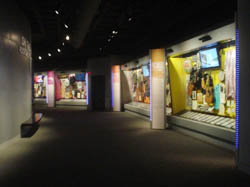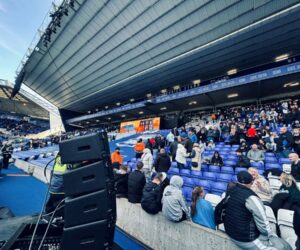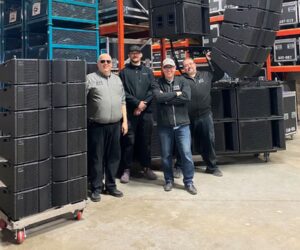The Rock and Roll Hall of Fame and Museum (RRHOF) contains the most comprehensive collection of rock music exhibits and artifacts in the world.
Recently, in order to enhance the overall experience for its 400,000 plus annual visitors, the Rock and Roll Hall of Fame and Museum decided to upgrade the loudspeaker system in its main exhibit halls.
Following an extensive evaluation, K-array loudspeakers were chosen due to their outstanding audio intelligibility, sound dispersion characteristics and diminutive footprint.
The museum, which has seven floors and over 150,000 square feet of exhibition space, explores the entire history of the genre through the eyes and ears of the musicians, producers and engineers who made it all possible.
One of the primary installation locations is an exhibit called City and Sounds, which takes visitors through different locations and time periods that were instrumental in the evolution of rock music.
In addition to priceless artifacts and displays, the exhibit contains plenty of music and interviews to lend first person perspective and insight. Physically, the exhibit environment is a semi-circle, with roughly 20 displays encasements on both sides in addition to seven audio/video exhibits.
“Before installing the K-arrays, we had a lot of unintelligible sound coming from rather important audio sources, as well as a lot of bleed over between the casework,” recalls Raymond Kent, director of the innovative technology design group at system designer Westlake Reed Leskosky.
“The previous loudspeakers were pointed out in the space at a rather high SPL and a 90-degree dispersion—effectively throwing sound everywhere. We wanted to provide more focused sound dispersion within each exhibit, while providing greater control over audio bleed into adjacent exhibits.”
Westlake Reed Leskosky and A/V integrator AVI/SPL introduced the K-array KK50vb as a prospective solution, and set up a mock environment that included two other competitive speaker brands.
“We put up all three speakers and did sort of a ‘blind taste test’—not just for ourselves and the museum staff, but also for the visitors,” Kent recalls. “Based on the impressions of everyone that listened to them, the K-array was clearly the right choice.”
After handily passing the preliminary evaluation, the team installed a total of 14 K-array KK50vbs, along with seven K-array KA10 four channel power amplifiers.
The elevation in audio quality was noticeable: “Since installing the K-arrays, we have had a more focused sound, and we’ve been better able to direct and control the audio,” observes Rob Weil, director of production at RRHOF.
“The KK50vb also has an extremely small footprint so it works well in a museum with casework where you want the audio to be heard, but not seen. In fact, we were able to discreetly mount the KK50vb directly on the case; this would not have been possible with a more traditional speaker.”
While the extremely small footprint of the KK50vb as a key factor, Kent concludes the ultimate decision to go with K-array was based primarily on audio quality. “We had great intelligibility and a very focused sound dispersion,” he says.
“Everything sounded much clearer with the K-arrays—this difference was audible to everyone.” Moving forward, the RRHOF has already specified K-array for its Rolling Stones and Beatles exhibits, and it is expected to complete installation of the new K-array units by this May.
The KK50vb is a compact line array element comprised of 9 x 2-inch neodymium transducers in a strong stainless steel chassis. The dispersion pattern can be configured for 7-degree ‘spot’ coverage or 120-degree ‘flood’ coverage. The speaker has an impedance of 16 Ohms, eliminating the need for 70-volt transformers in distributed systems.
Features
• Unique performance-to-size ratio
• Vertical, horizontal and 3D line-array applications
• Multiple 2–inch-long-excursion full-range cone drivers
• Wide horizontal coverage
• Switchable vertical coverage: 7 degrees or 120 degrees
• Electronically protected
• Integrated mounting hardware and accessories
• Selectable channel 1 or 2
• Top quality components for outstanding performance
• Weather proof, suitable for outdoor installations
• Available in black or white




















